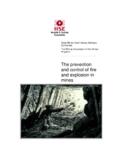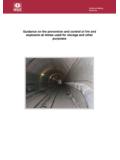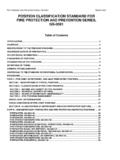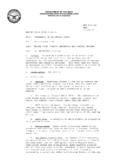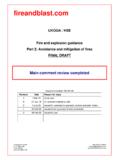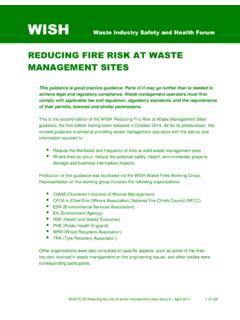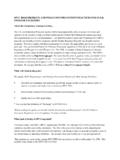Transcription of Laboratory Safety Guidance - osha.gov
1 Laboratory SafetyGuidanceOSHA 3404-11R 2011 OccupationalSafetyandHealthActof1970 To assure safe and healthful working conditionsfor working men and women; by authorizingenforcement of the standards developed underthe Act; by assisting and encouraging the States intheir efforts to assure safe and healthful workingconditions; by providing for research, information,education, and training in the field of occupationalsafety and health. This publication provides a general overview of aparticular standards-related topic. This publicationdoes not alter or determine compliance responsibilitieswhich are set forth in osha standards, and theOccupational Safety and Health Act of , because interpretations and enforcementpolicy may change over time, for additional guidanceon osha compliance requirements, the readershould consult current administrative interpreta-tions and decisions by the Occupational Safetyand Health Review Commission and the contained in this publication is in the publicdomain and may be reproduced, fully or partially,without permission.
2 Source credit is requestedbut not information will be made available to sensory-impaired individuals upon request. Voice phone:(202) 693-1999; teletypewriter (TTY) number: SafetyGuidanceOccupational Safety and Health Department of LaborOSHA 3404-11R20112 Occupational Safety andHealth AdministrationThis Guidance document is not a standard or regulation, and itcreates no new legal obligations. It contains recommendations aswell as descriptions of mandatory Safety and health standards. Therecommendations are advisory in nature, informational in content,and are intended to assist employers in providing a safe and health-ful workplace. TheOccupational Safety and Health Actrequiresemployers to comply with Safety and health standards and regula-tions promulgated by osha or by a state with an osha -approvedstate plan. In addition, the Act s General Duty Clause, Section5(a)(1), requires employers to provide their employees with a work-place free from recognized hazards likely to cause death or seriousphysical A B O R A T O R Y S A F E T Y3 ContentsIntroduction4 osha Standards5 Hierarchy of Controls8 Chemical Hazards9 Laboratory Standard9 Hazard Communication Standard13 Specific Chemical Hazards13 Air Contaminants Standard13 Formaldehyde Standard14 Latex15 Chemical Fume Hoods15 Biological Hazards15 Biological Agents (other than BloodbornePathogens) and Biological Toxins15 Bloodborne Pathogens17 Research Animals19 Biological Safety Cabinets (BSCs)
3 21 Physical Hazards and Others21 Ergonomic Hazards21 Ionizing Radiation21 Non-ionizing Radiation22 Noise23 Safety Hazards24 Autoclaves and Sterilizers24 Centrifuges24 Compressed Gases24 Cryogens and Dry Ice25 Electrical25 Fire26 Lockout/Tagout27 Trips, Slips and Falls28 References29 Appendices30 Additional osha Information30 Other Governmental and Non-governmentalAgencies Involved in Laboratory Safety40 Most Common Zoonotic Diseasesin Animal Workers45 Complaints, Emergenciesand Further Assistance46 osha Regional Offices48 IntroductionMore than 500,000 workers are employed in labora-tories in the The Laboratory environment canbe a hazardous place to work. Laboratory workersare exposed to numerous potential hazards includ-ing chemical, biological, physical and radioactivehazards, as well as musculoskeletal Safety is governed by numerous local,state and federal regulations. Over the years, OSHAhas promulgated rules and published Guidance tomake laboratories increasingly safe for document is intended for supervisors, principalinvestigators and managers who have the primaryresponsibility for maintaining laboratories undertheir supervision as safe, healthy places to workand for ensuring that applicable health, safetyand environmental regulations are Guidance in the form of Fact Sheets andQuickCards is also provided for certain hazardsthat may be encountered in laboratories.
4 There areseveral primary osha standards that apply tolaboratories and these are discussed below. Thereare also other osha standards that apply to variousaspects of Laboratory activities and these arereferred to in this Occupational Exposure to Hazardous Chemicalsin Laboratories standard (29 CFR ) wascreated specifically for non-production osha standards provide rules thatprotect workers, including those that who in labora-tories, from chemical hazards as well as biological,physical and Safety hazards. For those hazards thatare not covered by a specific osha standard, osha often provides Guidance on protecting workers fromthese hazards. This document is designed to makeemployers aware of the osha standards as well asOSHA Guidance that is available to protect workersfrom the diverse hazards encountered in laborato-ries. The extent of detail on specific hazards provid-ed in this document is dependent on the nature ofeach hazard and its importance in a Laboratory set-ting.
5 In addition to information on osha standardsand Guidance that deal with Laboratory hazards,appendices are provided with information on othergovernmental and non-governmental agencies thatdeal with various aspects of Laboratory Laboratory Safety Guidance booklet dealsspecifically with laboratories within the jurisdictionof Federal osha . There are twenty-five states andtwo Territories (Puerto Rico and the VirginIslands) that have their own osha -approved occu-pational Safety and health standards, which may bedifferent from federal standards, but must be atleast as effective as the federal your local or state osha office for furtherinformation. More information on osha -approvedstate plans is available Safety andHealth AdministrationOSHA StandardsSection 5(a)(1) of theOccupational Safety andHealth Act of 1970(OSH Act), theGeneral DutyClause, requires that employers shall furnish toeach of his employees employment and a place ofemployment which are free from recognized haz-ards that are causing or likely to cause death or seri-ous physical harm to his employees.
6 Therefore,even if an osha standard has not been promulgat-ed that deals with a specific hazard or hazardousoperation, protection of workers from all hazards orhazardous operations may be enforceable undersection 5(a)(1) of the OSH Act. For example, bestpractices that are issued by non-regulatory organi-zations such as the National Institute forOccupational Safety and Health (NIOSH), theCenters for Disease Control and Prevention (CDC),the National Research Council (NRC), and theNational Institutes of Health (NIH), can be enforce-able under section 5(a)(1).The principal osha standards that apply to all non-production laboratories are listed below. Althoughthis is not a comprehensive list, it includes stan-dards that cover the major hazards that workers aremost likely to encounter in their daily must be fully aware of these standardsand must implement all aspects of the standardsthat apply to specific Laboratory work conditions intheir Occupational Exposure to Hazardous Chemicalsin Laboratories standard (29 CFR ), com-monly referred to as the Laboratory standard,requires that the employer designate a ChemicalHygiene Officer and have a written ChemicalHygiene Plan (CHP), and actively verify that itremains effective.
7 The CHP must include provisionsfor worker training, chemical exposure monitoringwhere appropriate, medical consultation whenexposure occurs, criteria for the use of personalprotective equipment (PPE) and engineering con-trols, special precautions for particularly hazardoussubstances, and a requirement for a ChemicalHygiene Officer responsible for implementation ofthe CHP. The CHP must be tailored to reflect thespecific chemical hazards present in the laboratorywhere it is to be used. Laboratory personnel mustreceive training regarding the Laboratory standard,the CHP, and other Laboratory Safety practices,including exposure detection, physical and healthhazards associated with chemicals, and Hazard Communication standard (29 ), sometimes called the HazCom standard,is a set of requirements first issued in 1983 byOSHA. The standard requires evaluating the poten-tial hazards of chemicals, and communicating infor-mation concerning those hazards and appropriateprotective measures to employees.
8 The standardincludes provisions for: developing and maintaininga written hazard communication program for theworkplace, including lists of hazardous chemicalspresent; labeling of containers of chemicals in theworkplace, as well as of containers of chemicalsbeing shipped to other workplaces; preparation anddistribution of material Safety data sheets (MSDSs)to workers and downstream employers; and devel-opment and implementation of worker training pro-grams regarding hazards of chemicals and protec-tive measures. This osha standard requires manu-facturers and importers of hazardous chemicals toprovide material Safety data sheets to users of thechemicals describing potential hazards and otherinformation. They must also attach hazard warninglabels to containers of the chemicals. Employersmust make MSDSs available to workers. They mustalso train their workers in the hazards caused by thechemicals workers are exposed to and the appropri-ate protective measures that must be used whenhandling the Bloodborne Pathogens standard (29 ), including changes mandated by theNeedlestick Safety and Prevention Act of 2001, re-quires employers to protect workers from infectionwith human bloodborne pathogens in the work-place.
9 The standard covers all workers with rea-sonably anticipated exposure to blood or otherpotentially infectious materials (OPIM). It requiresthat information and training be provided before theworker begins work that may involve occupationalexposure to bloodborne pathogens, annually there-after, and before a worker is offered hepatitis B vac-cination. The Bloodborne Pathogens standard alsorequires advance information and training for allworkers in research laboratories who handle humanimmunodeficiency virus (HIV) or hepatitis B virus(HBV). The standard was issued as a performancestandard, which means that the employer mustdevelop a written exposure control plan (ECP) toprovide a safe and healthy work environment, but isallowed some flexibility in accomplishing this other things, the ECP requires employers tomake an exposure determination, establish proce-L A B O R A T O R Y S A F E T Y56 Occupational Safety andHealth Administrationdures for evaluating incidents, and determine aschedule for implementing the standard s require-ments, including engineering and work practicecontrols.
10 The standard also requires employers toprovide and pay for appropriate PPE for workerswith occupational exposures. Although this stan-dard only applies to bloodborne pathogens, the pro-tective measures in this standard ( , ECP, engi-neering and work practice controls, administrativecontrols, PPE, housekeeping, training, post-expo-sure medical follow-up) are the same measures foreffectively controlling exposure to other Personal Protective Equipment (PPE) standard(29 CFR )requires that employers provideand pay for PPE and ensure that it is used wherever hazards of processes or environment, chemicalhazards, radiological hazards, or mechanical irri-tants are encountered in a manner capable of caus-ing injury or impairment in the function of any partof the body through absorption, inhalation or physi-cal contact. [29 CFR (a) and (h)].In order to determine whether and what PPE isneeded, the employer must assess the workplaceto determine if hazards are present, or are likely tobe present, which necessitate the use of [PPE], 29 CFR (d)(1).










